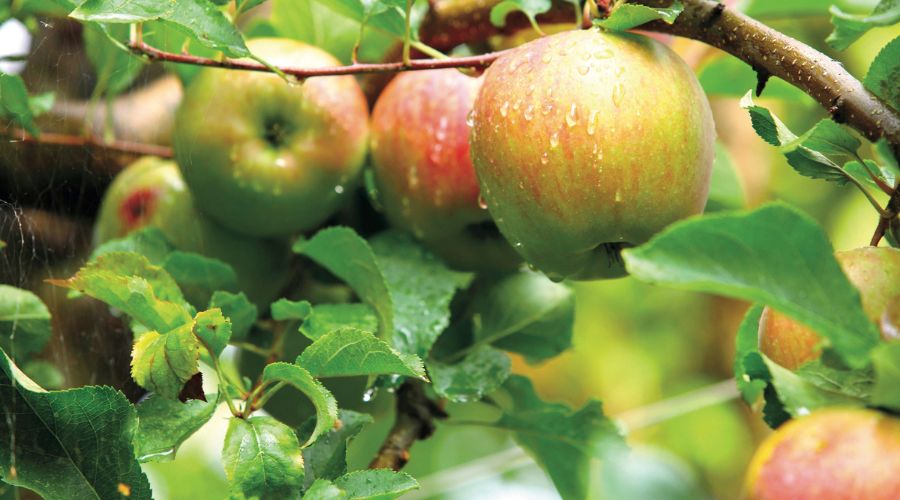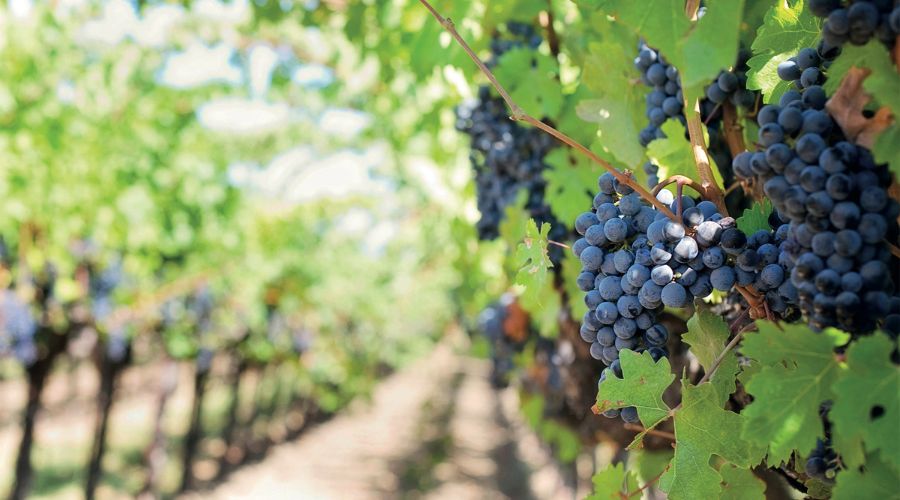Top fruit nutrition: Getting the balance right in turbulent years
17th January 2025
After a year of unusually heavy rainfall, keeping a close eye on top fruit nutrition will be particularly important – Agrii agronomists shared their expertise during a recent podcast. Sarah Kidby reports.


In years with turbulent weather, such as that seen over the past year with very heavy rainfall throughout the winter months, much of the nutrition put into top fruit trees the previous year may have been washed away or not be plant available, explained fruit agronomist Matt Greep. “The level of investment we make in year one isn’t always returned in years two and three. We need to continually assess it, look at the situation in that cropping year and see if we need to make any adjustments,” he added.
Ryan Williams, another agronomist at Agrii who works with apples, pears, cherries and plums, as well as soft fruit and vines, noted that when plants are not given the correct nutrition, they will be far more susceptible to pests and disease, and less likely to withstand the turbulent weather conditions. In some cases, this leads to the death of the plant, and huge expense for the grower in removing and replanting it.
With some top fruit trees in the ground for as long as 30 years, for example in cider production, growers are always thinking ahead and what we do in the present year is laying the groundwork for next year’s fruit, added agronomist Emma Smith.
Macro and micronutrients
The key macronutrients required for most fruit crops are nitrogen, potassium, phosphorous and calcium – and the latter is particularly important for cell division, quality and strength, especially for apples and pears, Mr Greep said. Soft fruit shares these requirements and may need additional nutrients, whilst for vine crops magnesium, iron and manganese can all be essential to the quality of the crop.
Meanwhile boron and zinc are two of the main micronutrients for top fruit crops during and just before the flowering period, Ryan continued. This helps to strengthen the pollen tubes for healthy fulfilling flowers, which will eventually bear the crop. Additionally, post-harvest storage disorders can be seen in fruit, causing problems in the packing process if plants are deficient in these nutrients.

Moving onto post-harvest nutrition, he emphasised the importance of giving the crop sufficient nutrients going through to the dormant winter period to ensure flowers are strong and healthy during the first stage of growing in March and April. Prior to the flowering period the tree does not use any nutrition from the soil but purely relies on its carbohydrate reserves.
Crop nutrition is also particularly key in UK crops such as strawberries which are now grown almost exclusively in coir in the UK, Matt added. As coir doesn’t carry any nutritional value, the crop must be fertigated with the right balance of essential nutrients for the plant’s growing stage, to prevent it going into a vegetative state.
When it comes to knowing which crops to give which nutrients, and at what time, the Nutrient Management Guide (RB209) – section 7 for fruit crops and vines – provides a database of knowledge. Agrii agronomists carry out crop walks and monitoring every 10–14 days throughout the growing season, including visual assessments of the colour and productivity of the leaf and overall plant.
Soil and tissue analysis, and when the time comes, fruitlet analysis, will highlight if the tree is out of balance, Ryan explained. Tissue analysis is generally carried out twice per season, once after blossoming and again around harvest time. Nutritional deficiencies can be spotted by eye so if anything stands out halfway through the season then it’s always advisable to take a sample then as well, Emma added.
Role of biostimulants
Over 50% of Agrii’s R&D trials each year are specifically around biostimulants, according to Matt, and the company is actively trying to develop this sector of the market – which is still quite unknown and relatively new. Biostimulants not only stimulate the plant’s defences, they can also boost nutrient use efficiency and pest control, and improve availability of nutrients within the soil.
Giving an example of a product used by Agrii, Ryan said ProAct effectively primes the plant and can assist with the uptake of calcium. It’s applied 2–3 times a year in top fruit, around blossom time and petal fall, and again pre-harvest. It can also provide some properties that make crops more resilient to frost, resulting in a better quantity and quality of crop.
As the UK sees more adverse weather conditions – wetter winters, hotter summers and occasionally later frosts – top fruit crops may still suffer frost events during flowering in mid to late April, and into early May.
Commenting on the potential for biostimulants in top fruit growing, Matt said: “Think back to when you experienced a normal season in the UK. It’s almost rhetorical because I don’t recall one at all in the nine years I’ve been with Agrii. We’re seeing far more adverse weather events – really hot summers, very wet winters and protracted periods of wetness – and what that leads to is a cropping system under enormous environmental stresses throughout the entire season, and quite often it’s going from one extreme to the other.
“This reduces the plant’s ability to overcome stress and carry out its normal metabolic functions. So if we can use something like a biostimulant to reduce the stress impacts on the crop around these weather events, that’s going to help it function normally and produce a crop.”
Key take-home messages
“For me, it’s probably monitoring, monitoring, monitoring,” said Ryan, when asked for his key advice for getting the balance right with top fruit nutrition.

“That starts in the orchard, crop walking and looking for foliar deficiencies in trees and fruits, which can also be assessed using tissue and soil analysis. We can also see the results of this go through to post-harvest and affecting shelf life.”
He also reiterated the importance of calcium in the crucial six-week period after bloom for cell division and expansion when roughly 90% of calcium is taken in by the plant. One of the most important nutritional deficiencies seen in post-harvest cold store is bitter pit, a calcium deficiency most commonly seen in some of the older varieties like Cox and Bramley.
“It presents as small brown pits in the apple flesh and, when severe, it can be visible from the outside of the fruit. So if the fruit isn’t nutritionally balanced some of these problems can rear their heads,” Ryan concluded.
Meanwhile, Emma stressed the importance of analysis to ensure you’re giving the plant what it needs so it can withstand post-harvest life.
Address yield-sapping nutrient deficiencies more easily

ICL is making its low carbon footprint, multi-nutrient fertiliser Polysulphate (48% SO3, 14% K2O, 17% CaO and 6% MgO) available to fruit and vine producers in a special ‘Mini Granular’ formulation in easy-to-manage 25kg bags.
As sulphur and other key nutrient deficiencies increase across the UK and growers seek sustainable methods for boosting soil fertility, the new format could bring the benefits of Polysulphate to a much wider range of producers, says ICL’s Andrew Judd.
“Mined in North Yorkshire, Polysulphate is a natural product with the lowest carbon footprint of any fertiliser at 0.0029kg CO2e/kg product, making it an ideal choice for growers looking to decarbonise their production.
“It’s been proven to lift yields and improve crop quality significantly in a wide range of crops, including in top fruit and grape production.
“Polysulphate is approved by the Soil Association and Organic Farmers and Growers, plus it is a perfect fit for growers following the Sustainable Wines of Great Britain (SWGB) certification scheme.”
Applied at a recommended 50g/m2 (500kg/ha) to top fruit and vineyards by hand, domestic spreaders or tractor mounted equipment, Polysulphate provides four essential water-soluble nutrients in a single application, he explains.

“The slow-release potassium, magnesium and calcium in Polysulphate will be of significant interest to wine grape growers. Particularly potassium, as this is essential for fruit quality and sugar development and vines use about 3kg of potassium for every tonne of grapes harvested.”
Agrii will be working with ICL to make the new Mini Granular product available to fruit and vine growers across the country.
“Agrii fruit agronomists use Polysulphate in many forms when advising nutrient management plans for our wine grape growing customers and top fruit customers,” says Agrii agronomist and fruit team manager, Matt Greep.
“Be it Potash Plus or Agrii Fruit 50 – the Polysulphate component is perfectly balanced for fruit crops that have a high potassium requirement for yield and quality of the crop.
“This bespoke mini-granule Polysulphate in a 25kg bag is going to help vineyards of all scales make a more targeted and sustainable approach to the fertilisation of their grapes.
“The fact that it’s a 100% soluble organic fertiliser and has no effect on soil pH with all the potassium in the product being potassium sulphate with no chloride in its granule, is a real bonus for fruit and vine producers.”
Read more fruit news.
